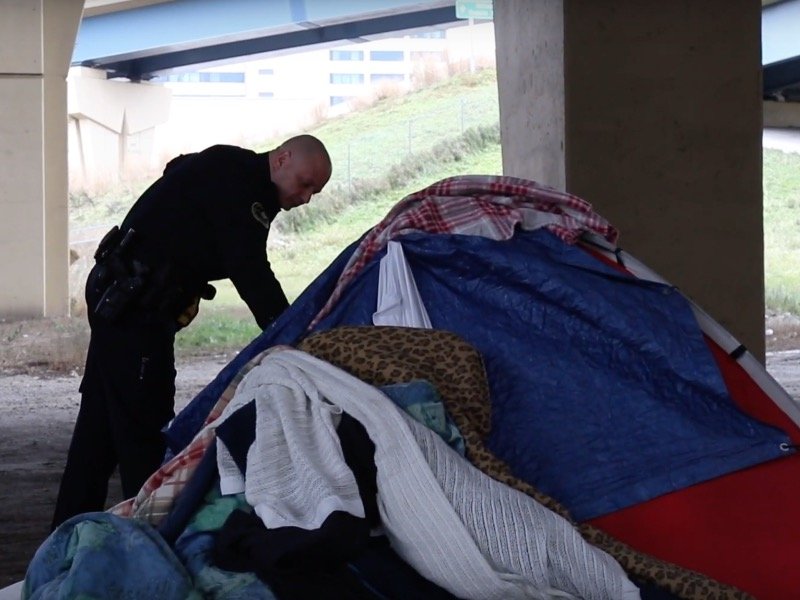On a grey cloudy morning in Milwaukee, a bright pink Barbie tent stuck out among the sea of tents below the north end of the 6th Street Bridge. It was a newer addition to the tent encampment on North 6th and West Clybourn Streets that has been occupied by a group of Milwaukee’s homeless.
The man inside was wearing a bright yellow rain jacket, but his disposition was anything but sunny.
Thomas Kline, community liaison officer for District 1 of the Milwaukee Police Department, has been visiting the city’s various encampments and checking up on the individuals living there, but he didn’t recognize the man.
Kline introduced himself and began to explain the resources the city offers. He asked the man if he’s heard of the Housing First Initiative.
"I’ve heard this a million times," the man yelled.
Kline said that people are usually not angry when he offers information, but he understands his reaction. "He’s probably someone who’s been in the system for so long that he’s just so frustrated," Kline said.
Kline works to connect MPD District 1 Capt. Diana Rowe to residents through community meetings and events. Now, with homeless encampments growing more visible in the Downtown district within the last year, he spends 70-80 percent of his time working on issues related to homelessness.
On a frigid winter day, a person in a dog costume stood outside Milwaukee Police Department District 6, on the far South Side. The mascot danced enthusiastically in the cold, holding a sign that read "Milwaukee Police Department District 6 is accepting clothing items for the homeless."
Beside him was Officer Eric Ratzmann, who wore a jovial smile despite the ice crystals beginning to form on his beard. Ratzmann is part of MPD’s Homeless Outreach Team (HOT) in District 6 and helped to organize the drive.
"There’s homeless sleeping out under the bridges out here and sometimes people don’t want to go to shelters because they don’t like being around a lot of people," Ratzmann said. "We don’t want people to suffer, especially in the winter."
The Homeless Outreach Team started in 2010 with six officers. It expanded citywide, with several officers from each of MPD’s seven district on the team. HOT officers work to connect people with resources and aim to be perceived as "bridges" to assistance.
One critical resource is Milwaukee County’s Housing First Initiative, a program conducted in collaboration with the city and community partners that aims to provide housing before addressing the underlying cause of homelessness.
The Homeless Outreach Team’s work with homeless people is part of MPD’s community policing strategy, which focuses on building relationships with residents.
Dr. Meghan Stroshine, associate professor of criminology and law studies at Marquette University and co-author of "Policing: Continuity and Change," explained that community policing "emerged in response to the difficult relationship between the police and the public" in the 1960s, ’70s and ’80s.
She said research shows that community policing is having a positive effect on citizens’ view of police and improves officers’ ability to do their jobs because of greater cooperation from community members.
"In years past, the homeless population was treated or viewed as a problem to be dealt with, and police typically only got involved if there was a complaint from a resident or a business owner," Stroshine said. "Since community policing has emerged, that response has changed significantly."
Catrina Crane, director of workforce and business solutions at Menomonee Valley Partners, has worked directly with police to solve issues related to homelessness for businesses in the valley.
"We had a bigger homeless population years ago, but now the tents are making it more visible," Crane said. "They’re not hidden the way that they used to be."
According to the Housing First Initiative, about 900 homeless individuals live in Milwaukee, down from the nearly 1,500 when the program began in September 2015.
"Some of the homeless who have been in our area have been here for years and see the valley as their home," Crane said. "Although they may get into housing, they sometimes return because it’s what they know."
Every Saturday, volunteers from Street Life Communities set up folding tables and tents across the city to hand out whatever resources they have to people such as Timothy Flanigan, who is low-income and homeless.
Flanigan, 68, is a retired car salesman.
Shivering, the self-proclaimed "music lover, avid reader" and "mean guitar player" stood in line for a cup of hot coffee and a Styrofoam container of food.
Flanigan discovered the Street Life gatherings about three years ago when he found himself without housing. Throughout his adult life, he has struggled with mental illness, and episodes of stress have caused him to fluctuate between home stability and homelessness, he said.
"I’m not always homeless, but I have these spells. I have bipolar disorder and it gets the best of me and things kind of fall apart," Flanigan said.
He noted that police have helped him several times when he was in a mental health crisis, but says he doesn’t need information about resources from the Homeless Outreach Team. He said he knows Milwaukee’s streets and resources well, and finding a solution is not as easy as it may seem.
"I’ve been trying to contact Housing First Milwaukee via email; they don’t answer," Flanigan said. "The wheels turn very slowly."
While out on the streets, Flanigan does what he can to reduce his stress levels. He will spend a few dollars at a 24-hour diner, nursing a cup of coffee to avoid the cold. What he needs most is a stable roof above his head.
"I can get food, I can get clothes, I can get medical and legal help, I can even get a guy to sit with me over coffee and commiserate a little bit. But I can’t get housing," Flanigan said. "We have what we need except the one thing we need more than anything."



.jpeg)


.jpeg)
